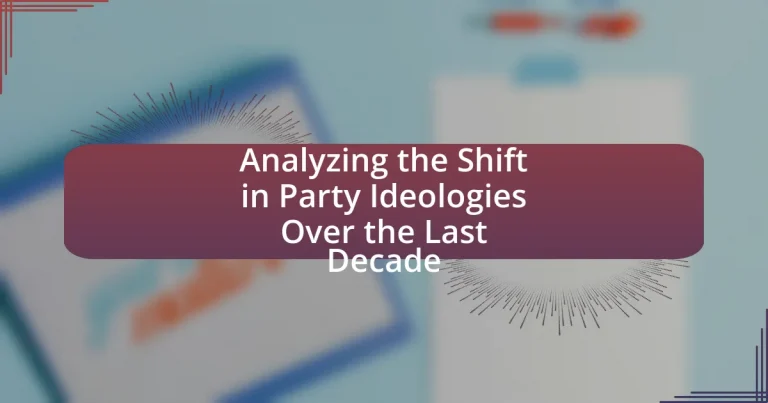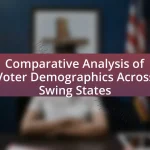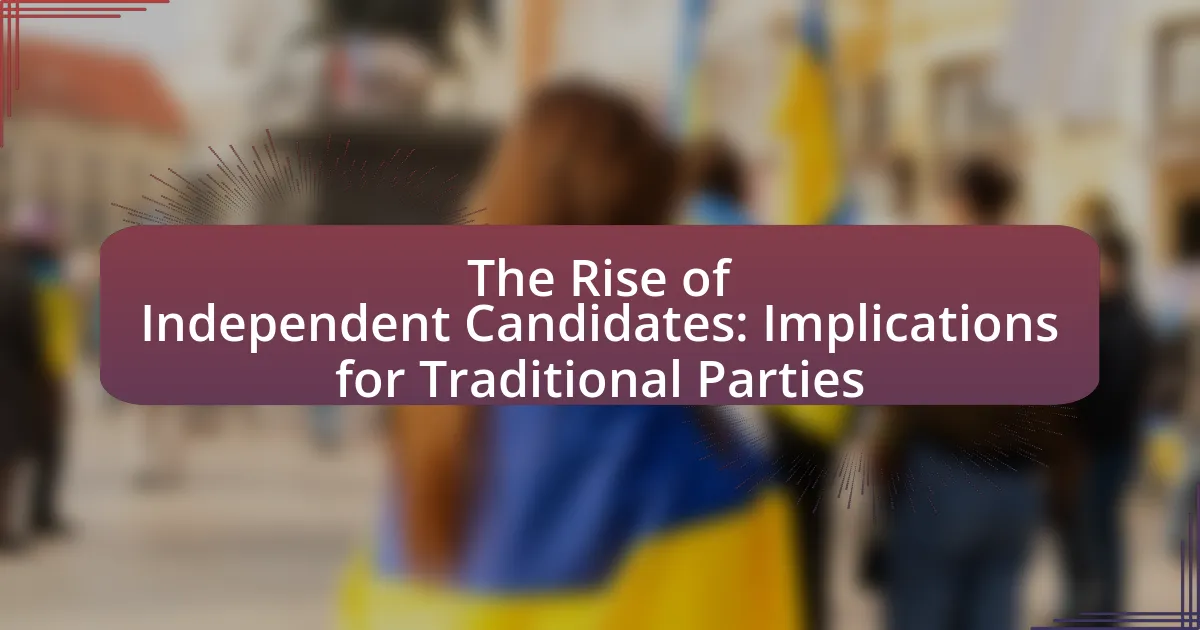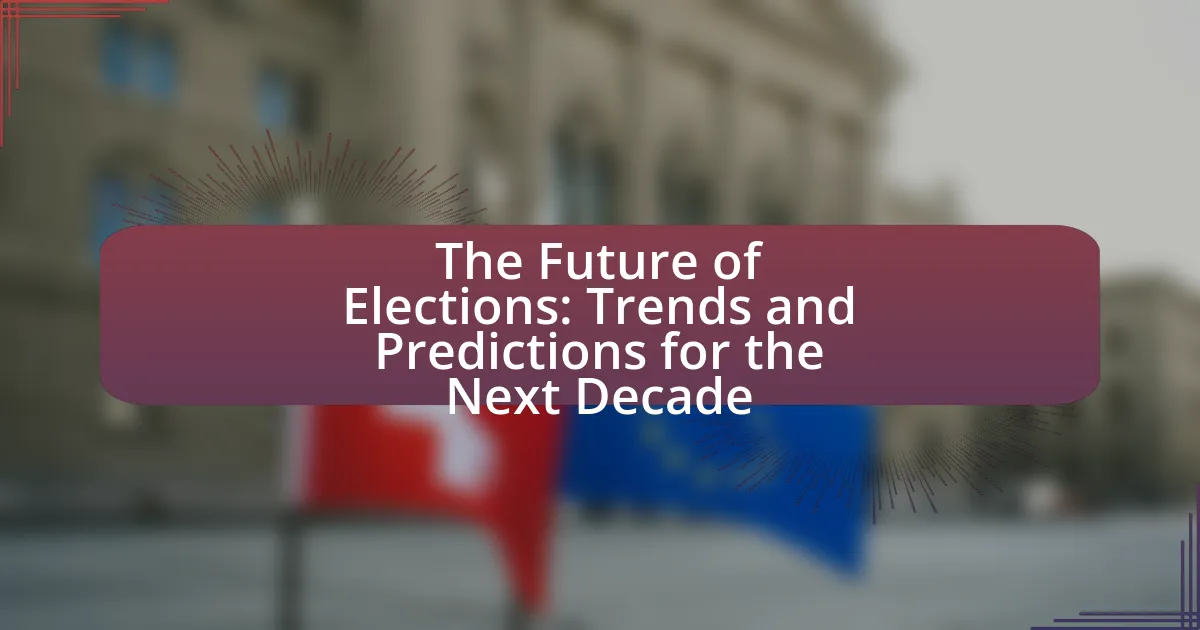The article analyzes the significant shifts in party ideologies over the last decade, focusing on key factors such as demographic changes, economic inequality, and the influence of social movements. It highlights how movements like Black Lives Matter and climate activism have reshaped political priorities, prompting parties to adopt more progressive stances. Additionally, the article discusses the impact of economic changes and technological advancements on party platforms, illustrating how these elements have contributed to increased polarization and the emergence of new political entities. The analysis also addresses the challenges parties face in adapting to these ideological shifts while maintaining cohesion and effectively engaging with evolving voter demographics.

What are the key factors influencing the shift in party ideologies over the last decade?
The key factors influencing the shift in party ideologies over the last decade include demographic changes, economic inequality, and the rise of social movements. Demographic changes, such as increasing diversity in the electorate, have prompted parties to adapt their platforms to appeal to a broader range of voters. Economic inequality has led to a growing discontent with traditional party policies, pushing parties to adopt more progressive stances on issues like wealth redistribution and social justice. Additionally, the rise of social movements, particularly around issues like climate change and racial equality, has pressured parties to align their ideologies with the values and demands of grassroots activism. These factors collectively illustrate the dynamic nature of political ideologies in response to societal shifts.
How have social movements impacted party ideologies?
Social movements have significantly influenced party ideologies by shifting political priorities and reshaping public discourse. For instance, the Black Lives Matter movement has compelled many political parties to adopt more progressive stances on racial justice and police reform, reflecting a broader societal demand for equity. Similarly, the climate movement has pushed parties, particularly in Europe and North America, to integrate environmental sustainability into their platforms, leading to the rise of green policies and parties. These shifts are evidenced by the increasing incorporation of social justice and environmental issues in party manifestos and legislative agendas, demonstrating that social movements can effectively alter the ideological landscape of political parties.
What specific social movements have played a role in this shift?
The specific social movements that have played a role in the shift in party ideologies over the last decade include the Black Lives Matter movement, the Me Too movement, and the climate justice movement. The Black Lives Matter movement has significantly influenced discussions around racial equality and police reform, prompting political parties to adopt more progressive stances on these issues. The Me Too movement has reshaped conversations about gender equality and sexual harassment, leading to increased advocacy for women’s rights within party platforms. Additionally, the climate justice movement has pushed for stronger environmental policies, compelling parties to prioritize climate action and sustainability in their agendas. These movements have mobilized public opinion and shifted political discourse, resulting in a notable transformation in party ideologies.
How do these movements reflect changing public sentiments?
These movements reflect changing public sentiments by demonstrating a shift towards progressive values and social justice. For instance, the rise of movements such as Black Lives Matter and climate activism indicates a growing public demand for equity and environmental responsibility. According to a 2021 Pew Research Center survey, 61% of Americans believe that the government should do more to address racial inequality, highlighting a significant shift in public opinion. This change in sentiment is also evident in the increasing support for policies like universal healthcare and climate action, which have gained traction in political discourse over the past decade.
What role has economic change played in altering party ideologies?
Economic change has significantly influenced the evolution of party ideologies by reshaping priorities and voter bases. For instance, the rise of globalization and technological advancements has led to increased economic inequality, prompting left-leaning parties to adopt more progressive stances on wealth redistribution and social welfare. Conversely, right-leaning parties have shifted towards populism, emphasizing nationalism and protectionist policies to appeal to economically disenfranchised voters. This ideological shift is evidenced by the 2016 U.S. presidential election, where economic discontent played a crucial role in Donald Trump’s victory, as he capitalized on the frustrations of working-class voters affected by deindustrialization.
How have economic crises influenced party platforms?
Economic crises have significantly influenced party platforms by prompting shifts towards more interventionist policies and social safety nets. For instance, during the 2008 financial crisis, many political parties, particularly in the United States and Europe, adopted platforms that emphasized increased government spending and regulation to stabilize the economy and protect vulnerable populations. This shift was evident in the Democratic Party’s focus on healthcare reform and financial regulations, as seen in the Affordable Care Act and the Dodd-Frank Act, which aimed to address the economic fallout and prevent future crises. Similarly, European parties, facing austerity measures, began advocating for stronger social welfare programs to mitigate the impact of economic downturns, reflecting a broader trend towards prioritizing economic security in party platforms.
What economic policies have emerged as a result of these shifts?
Recent shifts in party ideologies have led to the emergence of progressive economic policies focused on wealth redistribution, climate change mitigation, and social equity. For instance, the adoption of policies such as universal basic income and increased taxation on the wealthy reflects a growing emphasis on reducing income inequality. Additionally, the Green New Deal initiatives highlight a commitment to sustainable economic practices aimed at addressing climate change, which have gained traction among progressive factions. These policies are supported by data indicating that income inequality has risen significantly over the past few decades, necessitating government intervention to promote economic fairness and environmental sustainability.
How has technology affected political communication and party ideologies?
Technology has significantly transformed political communication and party ideologies by enabling instant information dissemination and fostering direct engagement between politicians and the electorate. The rise of social media platforms, such as Twitter and Facebook, has allowed political parties to communicate their messages rapidly and interactively, leading to a shift in how ideologies are presented and perceived. For instance, during the 2016 U.S. presidential election, candidates utilized social media to bypass traditional media filters, directly reaching millions of voters and shaping public discourse. This shift has resulted in the emergence of more populist and polarized ideologies, as parties adapt their messages to resonate with specific online communities and demographics. Research by the Pew Research Center indicates that social media has become a primary source of news for many Americans, further influencing party strategies and ideological alignment.
What platforms have changed the way parties communicate their ideologies?
Social media platforms, particularly Facebook, Twitter, and Instagram, have fundamentally changed the way political parties communicate their ideologies. These platforms enable direct interaction with the electorate, allowing parties to disseminate their messages rapidly and engage in real-time discussions. For instance, during the 2016 U.S. presidential election, over 80% of voters reported using social media to follow candidates, illustrating the platforms’ significant role in shaping political discourse. Additionally, the use of targeted advertising on these platforms has allowed parties to tailor their messages to specific demographics, enhancing the effectiveness of their communication strategies.
How has social media influenced voter perceptions of party ideologies?
Social media has significantly influenced voter perceptions of party ideologies by facilitating the rapid dissemination of information and shaping public discourse. Platforms like Twitter and Facebook allow political parties to communicate directly with voters, bypassing traditional media filters, which can lead to a more polarized understanding of ideologies. For instance, a study by the Pew Research Center in 2020 found that 53% of social media users reported that their views on political issues were influenced by content they encountered online. This direct engagement can reinforce existing beliefs and create echo chambers, where voters are exposed primarily to viewpoints that align with their own, thus distorting their perceptions of party ideologies.
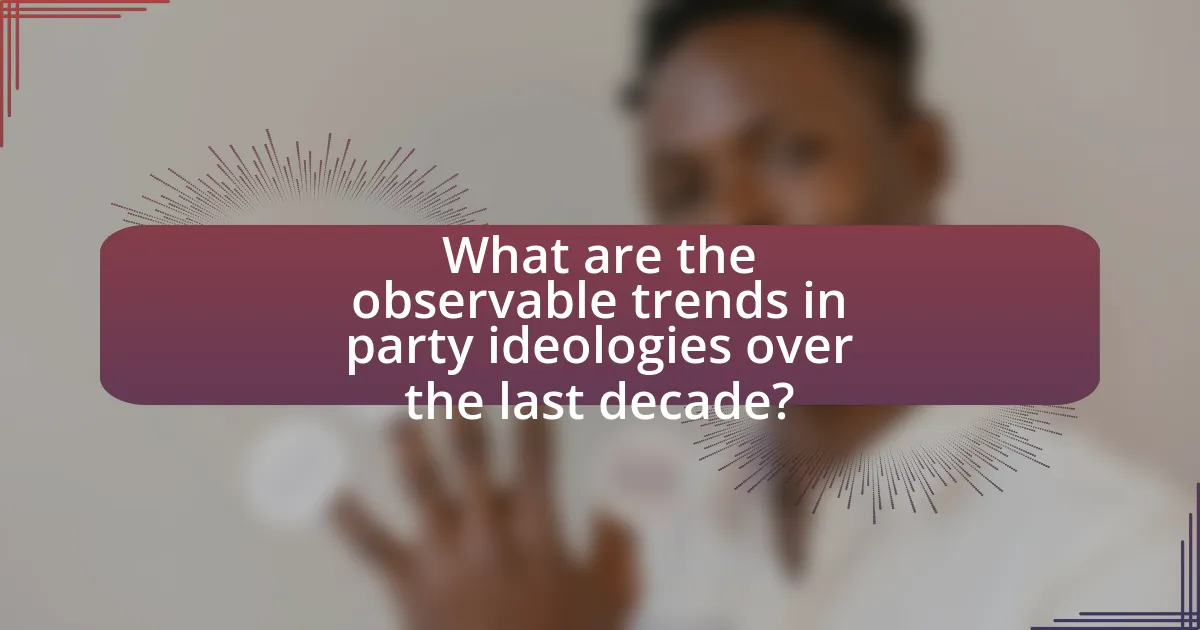
What are the observable trends in party ideologies over the last decade?
Observable trends in party ideologies over the last decade include a significant polarization between left and right parties, with left-leaning parties increasingly adopting progressive stances on social issues such as climate change, racial equality, and LGBTQ+ rights. Concurrently, right-leaning parties have shifted towards more nationalist and populist ideologies, often emphasizing immigration control and economic protectionism. For example, the rise of parties like the Democratic Socialists of America reflects a growing acceptance of socialist ideas within the U.S. left, while the success of populist leaders in Europe, such as Viktor Orbán in Hungary, illustrates the right’s embrace of nationalism. These shifts are evidenced by electoral outcomes, such as the 2020 U.S. presidential election, where Joe Biden’s platform included expansive social policies, contrasting sharply with Donald Trump’s focus on America First nationalism.
How have traditional party lines shifted in recent years?
Traditional party lines have shifted significantly in recent years, with both major U.S. political parties experiencing ideological realignment. The Democratic Party has increasingly embraced progressive policies, focusing on issues like climate change, healthcare reform, and social justice, while the Republican Party has leaned towards populism and nationalism, emphasizing immigration control and economic protectionism. This shift is evidenced by the rise of figures such as Bernie Sanders and Alexandria Ocasio-Cortez within the Democratic Party, who advocate for more leftist policies, and the prominence of Donald Trump, who has reshaped the Republican Party’s platform to prioritize America First policies. According to a 2020 Pew Research Center study, 55% of Democrats now identify as liberal, up from 47% in 2016, while 47% of Republicans identify as conservative, reflecting a growing polarization between the two parties.
What examples illustrate the blurring of traditional party boundaries?
Examples illustrating the blurring of traditional party boundaries include the rise of populist movements and the increasing prevalence of independent candidates. Populist movements, such as those led by figures like Donald Trump in the United States and Jair Bolsonaro in Brazil, have attracted support from both conservative and progressive voters, challenging the established party lines. Additionally, the emergence of independent candidates, such as Bernie Sanders in the U.S. and Emmanuel Macron in France, has further blurred these boundaries by appealing to a broad spectrum of voters dissatisfied with traditional party platforms. These trends indicate a significant shift in voter alignment and party ideologies over the last decade.
How have new political parties emerged in response to these shifts?
New political parties have emerged in response to shifts in public sentiment and dissatisfaction with traditional parties. For instance, the rise of populist movements across various countries has led to the formation of parties like the Five Star Movement in Italy and Podemos in Spain, which capitalize on anti-establishment sentiments. These parties often focus on issues such as economic inequality, immigration, and political corruption, attracting voters who feel neglected by mainstream parties. The emergence of these new parties is evidenced by their significant electoral successes, such as the Five Star Movement winning 32% of the vote in the 2013 Italian general election, demonstrating a clear shift in voter preferences towards alternative political options.
What ideological shifts have occurred within major political parties?
Major political parties have experienced significant ideological shifts over the last decade, particularly in the United States and Europe. The Democratic Party has increasingly embraced progressive policies, focusing on issues like climate change, healthcare reform, and social justice, moving away from centrist positions that dominated in the early 2010s. Conversely, the Republican Party has shifted towards populism and nationalism, emphasizing immigration control and trade protectionism, which reflects a departure from traditional conservative values that prioritized free-market principles. This transformation is evidenced by the rise of figures like Bernie Sanders and Alexandria Ocasio-Cortez on the left, and Donald Trump on the right, who have reshaped their respective party platforms to align with these new ideological trends.
How have the Democratic and Republican parties evolved in their core beliefs?
The Democratic and Republican parties have evolved significantly in their core beliefs over the last decade, with Democrats increasingly embracing progressive policies on issues like healthcare and climate change, while Republicans have shifted towards populism and nationalism. For instance, the Democratic Party has moved from centrist positions to support for Medicare for All and the Green New Deal, reflecting a broader acceptance of government intervention in the economy and social justice issues. Conversely, the Republican Party has seen a rise in populist rhetoric, particularly under the influence of former President Donald Trump, emphasizing immigration control and trade protectionism, which marks a departure from traditional conservative principles of free-market economics. This evolution is evidenced by changes in party platforms and voter demographics, with younger voters aligning more with progressive Democratic ideals, while older and rural voters have gravitated towards the more nationalist Republican stance.
What impact have third parties had on the ideological landscape?
Third parties have significantly influenced the ideological landscape by introducing alternative viewpoints and challenging the dominant two-party system. Their presence has often shifted mainstream party platforms to address issues that may have been overlooked, such as environmental concerns and social justice. For instance, the Green Party has pushed the Democratic Party to adopt more progressive environmental policies, while the Libertarian Party has influenced Republican stances on personal freedoms and government intervention. Historical evidence shows that third parties, like Ross Perot’s Reform Party in the 1990s, can sway election outcomes and compel major parties to realign their ideologies to capture a broader electorate.
What demographic changes have influenced party ideologies?
Demographic changes such as increasing racial and ethnic diversity, shifting age distributions, and evolving educational attainment levels have significantly influenced party ideologies. For instance, the growing Hispanic population in the United States has led to Democratic Party shifts towards more inclusive immigration policies, reflecting the needs and values of this demographic. Additionally, younger voters, who tend to prioritize issues like climate change and social justice, have pushed both major parties to adopt more progressive stances. Data from the U.S. Census Bureau indicates that by 2020, non-Hispanic whites comprised less than 60% of the U.S. population, prompting parties to reconsider their platforms to appeal to a broader electorate. Furthermore, higher levels of education among younger voters have correlated with increased support for progressive policies, influencing party strategies and ideologies.
How have shifts in voter demographics affected party platforms?
Shifts in voter demographics have led political parties to adapt their platforms to better align with the changing preferences and values of their constituents. For instance, the increasing diversity in the U.S. electorate, particularly among younger voters and minority groups, has prompted the Democratic Party to emphasize issues such as racial equality, climate change, and social justice, which resonate more with these demographics. Conversely, the Republican Party has shifted focus towards issues like immigration control and economic conservatism to appeal to its base, which remains predominantly older and less diverse. This adaptation is evidenced by the Democratic Party’s platform changes in the 2020 election, which included a stronger emphasis on progressive policies to attract younger voters, while the Republican Party has maintained a focus on traditional conservative values to retain its core supporters.
What role do younger voters play in shaping party ideologies?
Younger voters significantly influence party ideologies by advocating for progressive policies and social issues. Their preferences often push political parties to adopt stances on climate change, social justice, and healthcare reform, reflecting the values of a generation that prioritizes inclusivity and sustainability. For instance, in the 2020 U.S. presidential election, 50% of voters aged 18-29 supported Joe Biden, who emphasized progressive reforms, showcasing how younger demographics can sway party platforms towards more liberal ideologies. This trend is supported by research from the Pew Research Center, which indicates that younger voters are more likely to identify as Democrats and support policies like universal healthcare and climate action, thereby reshaping the ideological landscape of political parties.
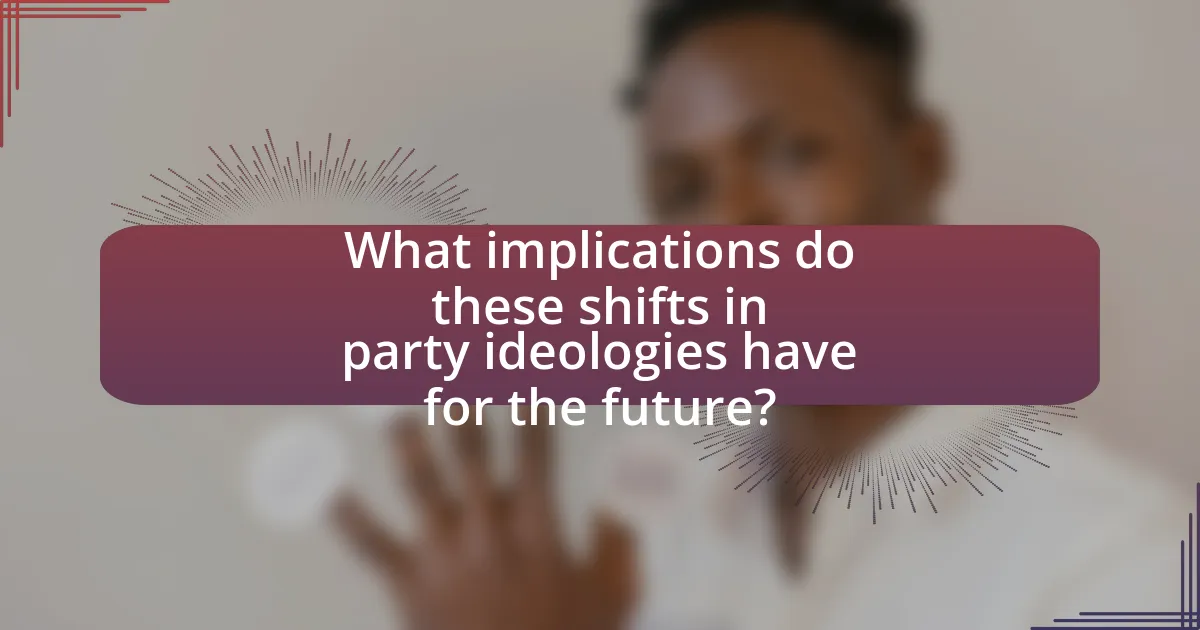
What implications do these shifts in party ideologies have for the future?
Shifts in party ideologies will likely lead to increased polarization and realignment of voter bases in the future. As parties adopt more extreme positions, they may alienate moderate voters, resulting in a fragmented political landscape. For instance, the rise of populist movements in various countries has demonstrated that traditional party structures can be disrupted, leading to the emergence of new political entities that challenge established norms. This trend is supported by data showing that in the United States, the percentage of voters identifying as independents has grown, indicating a shift away from traditional party loyalty. Consequently, these ideological shifts may result in more contentious elections and legislative gridlock, as parties prioritize ideological purity over compromise.
How might these ideological shifts affect future elections?
Ideological shifts can significantly influence future elections by altering voter alignment and party strategies. For instance, the increasing polarization observed in recent years has led to a more defined partisan identity among voters, which can result in higher voter turnout for parties that align closely with their beliefs. According to a Pew Research Center study, 55% of Americans now identify as either strongly liberal or strongly conservative, compared to 38% a decade ago, indicating a shift towards more extreme positions. This polarization can lead to more contentious elections, as candidates may cater to their base rather than seeking moderate support, ultimately affecting election outcomes and governance.
What strategies should parties adopt to align with changing ideologies?
Parties should adopt adaptive communication strategies to align with changing ideologies. This involves actively engaging with constituents through social media and town hall meetings to understand their evolving values and concerns. For instance, the Democratic Party’s shift towards progressive policies in response to grassroots movements like Black Lives Matter illustrates how parties can realign their platforms based on public sentiment. Additionally, conducting regular surveys and focus groups can provide data-driven insights into the electorate’s priorities, enabling parties to adjust their policies accordingly. This approach not only fosters trust but also ensures that party ideologies remain relevant in a rapidly changing political landscape.
How can parties effectively engage with new voter demographics?
Parties can effectively engage with new voter demographics by utilizing targeted outreach strategies that resonate with the specific values and concerns of these groups. For instance, research indicates that younger voters prioritize issues like climate change and social justice, which necessitates that parties incorporate these topics into their platforms and communications. Additionally, leveraging social media platforms, where these demographics are most active, allows for direct interaction and feedback, fostering a sense of community and involvement. Data from the Pew Research Center shows that 84% of young adults use social media, highlighting its importance in reaching this audience. By aligning messaging with the interests of new voter demographics and utilizing modern communication channels, parties can enhance their engagement and build lasting relationships with these voters.
What challenges do parties face in adapting to these ideological changes?
Parties face significant challenges in adapting to ideological changes, primarily due to internal divisions and voter polarization. Internal divisions arise as party members may disagree on new ideological directions, leading to conflicts that can weaken party cohesion. Voter polarization complicates this adaptation, as parties must navigate increasingly divergent views among their constituents, making it difficult to create a unified platform that appeals to a broad audience. For instance, the rise of populism and progressive movements has forced traditional parties to reassess their positions, often resulting in backlash from established members and factions within the party. This dynamic can hinder effective policy-making and electoral success, as parties struggle to balance competing interests and maintain relevance in a rapidly changing political landscape.
What internal conflicts might arise within parties due to ideological shifts?
Internal conflicts within parties due to ideological shifts can manifest as factionalism, where differing beliefs lead to divisions among members. For instance, when a party adopts more progressive policies, moderate members may resist these changes, resulting in tensions and potential splinter groups. Historical examples include the Democratic Party’s internal struggles during the 1960s over civil rights, which created rifts between traditionalists and reformists. Additionally, ideological shifts can lead to challenges in party unity, as seen in the Republican Party’s recent debates over populism versus traditional conservatism, causing friction among its base. These conflicts can hinder decision-making and electoral cohesion, ultimately affecting the party’s overall effectiveness and public perception.
How can parties maintain cohesion while embracing new ideologies?
Parties can maintain cohesion while embracing new ideologies by fostering open dialogue and establishing a shared vision that aligns with core values. Open dialogue allows members to express concerns and perspectives, which can lead to a more inclusive environment. Establishing a shared vision ensures that even as new ideologies are adopted, they do not stray too far from the foundational principles of the party. For instance, the Democratic Party in the United States has successfully integrated progressive ideas while maintaining its core commitment to social justice and equality, which has helped unify diverse factions within the party. This approach not only preserves unity but also enhances adaptability in a changing political landscape.
What best practices can parties implement to navigate ideological shifts?
Parties can implement several best practices to navigate ideological shifts effectively. First, conducting regular assessments of member and voter sentiments allows parties to identify emerging trends and adjust their platforms accordingly. For instance, the Democratic Party in the United States has increasingly focused on progressive issues like climate change and social justice in response to shifting voter priorities, particularly among younger demographics.
Second, fostering open dialogue within the party encourages diverse viewpoints and helps to reconcile differing ideologies. The Republican Party has seen internal debates over issues like immigration and healthcare, which have prompted discussions that can lead to a more unified stance that reflects a broader base.
Third, engaging with grassroots movements and community organizations can provide valuable insights into public concerns and aspirations. For example, the rise of movements such as Black Lives Matter has influenced party platforms to address systemic racism and police reform, demonstrating responsiveness to societal changes.
Lastly, utilizing data analytics to track voter behavior and preferences can inform strategic decisions and campaign messaging. The use of data-driven approaches in the 2020 election cycle by various parties highlighted the importance of tailoring messages to resonate with specific voter segments, thereby enhancing electoral success amidst ideological shifts.
How can parties effectively communicate their evolving ideologies to voters?
Parties can effectively communicate their evolving ideologies to voters by utilizing targeted messaging strategies across multiple platforms. This approach includes leveraging social media, traditional media, and community engagement to ensure that their messages resonate with diverse voter demographics. For instance, research indicates that 69% of Americans use social media to stay informed about political issues, highlighting the importance of digital platforms in reaching voters. Additionally, parties can host town hall meetings and forums to facilitate direct dialogue, allowing voters to engage with representatives and understand ideological shifts firsthand. This combination of digital outreach and personal interaction fosters transparency and builds trust, essential for conveying changes in party ideologies.
What role does grassroots engagement play in adapting to ideological changes?
Grassroots engagement plays a crucial role in adapting to ideological changes by facilitating direct communication between political leaders and constituents, allowing for the incorporation of diverse perspectives. This engagement enables parties to respond to shifting public sentiments and emerging social movements, as seen in the rise of progressive policies driven by grassroots activism in recent years. For instance, the Black Lives Matter movement significantly influenced the Democratic Party’s platform, pushing for reforms that reflect the demands of grassroots activists. Such engagement not only helps parties remain relevant but also fosters a sense of ownership among constituents, ensuring that ideological shifts align with the electorate’s values and needs.
